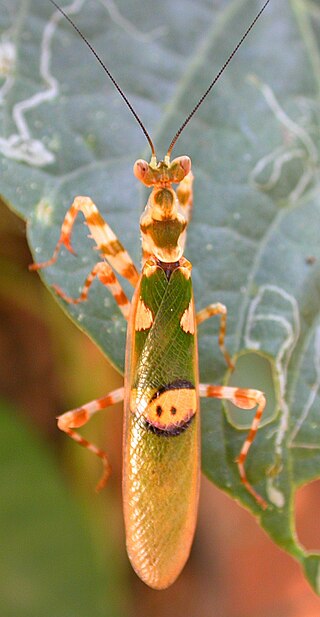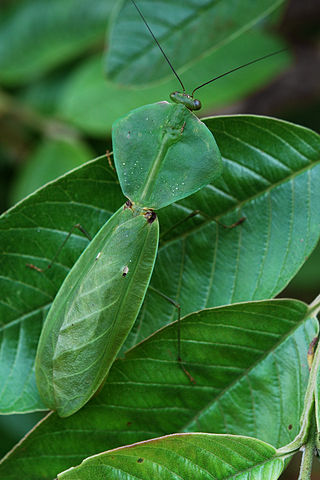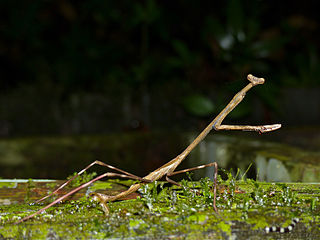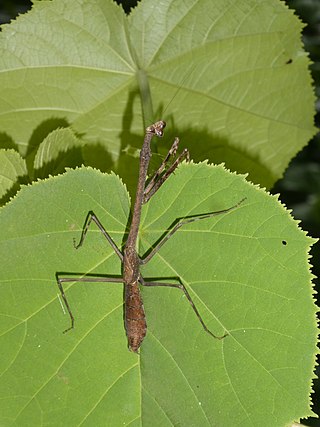
The Carolina mantis is a species of praying mantis of the subfamily Stagmomantinae.

The Chinese mantis is a species of mantis native to Asia and the nearby islands. In 1896, this species was accidentally introduced by a nursery tender at Mt. Airy near Philadelphia, United States. Tenodera sinensis often is erroneously referred to as Tenodera aridifolia sinensis because it was at first described as a subspecies of Tenodera aridifolia, but Tenodera sinensis is now established as a full species.

Hymenopodidae is a family of the order Mantodea (mantises), which contains six subfamilies. Some of the species in this family mimic flowers and are found camouflaged among them; these are called flower mantises. Their coloration is aggressive mimicry, luring prey to approach close enough to be seized and eaten.

Iris oratoria, known by the common name Mediterranean mantis, due to humans first studying it in lands around the Mediterranean Sea, is a species of praying mantis. Its range is expanding in the Middle East, Western Asia and the United States.

Creobroter is a genus of flower mantises in the tribe Hymenopodini; species are concentrated in Asia. The name comes from the Greek kreo-, meaning "flesh") and broter" meaning "eating", therefore, "flesh-eating", an apt name for a predatory insect. Both sexes have long wings and are capable fliers. Full-grown males are about 3 to 4 cm in length; females are about 4 to 5 cm.

Choeradodis is a genus of praying mantises with common names such as shield mantis, hood mantis, and leaf mantis because of their extended, leaf-like thoraces. The distinguishing characteristic of Choreododis from which it takes its common names is a laterally expanded thorax. This adaptation for the purpose of camouflage, as well as a rounded wing case and a habit of staying relatively flattened, aid its leaf mimicry. Tiny liverworts, lichens and fungi have been found growing on the pronotum and wing case of many Choeradodis mantids; these appear to be opportunistic growths rather than an example of coevolution with the mantids to afford extra camouflage.

Phyllocrania paradoxa, common name ghost mantis, is a small species of mantis from Africa remarkable for its leaf-like body. It is one of the three species in the genus Phyllocrania. It is known for its distinct and exclusive camouflaged appearance of a dry weathered leaf.
Titanodula grandis, also known as the giant Asian mantis, is a species of praying mantis native to the region around the Bay of Bengal in southern Asia. It is found in north-eastern India, Bangladesh, and Myanmar. It is a large mantis which grows up to 4 inches long.

Idolomantis is a monotypic genus of praying mantises in the family Empusidae. It contains the single species, Idolomantis diabolica, commonly known as the devil's flower mantis or giant devil's flower mantis. It is one of the largest species of praying mantises, and is possibly the largest that mimics flowers.

Metallyticus splendidus is a rare species of praying mantis found in Southeast Asia. It has an iridescent appearance.
Oxyopsis gracilis, common name South American green mantis, is a species of praying mantis native to South America. It is a medium sized mantis with adult females reaching 3” in length and adult males growing to about 1.5” in length. Individuals of these species are usually bright green.
Parasphendale affinis, common name budwing mantis, is a species of praying mantis. It is named for the female's short wings and can grow to 4 inches long and have a low mortality rate as nymphs. They originate from Kenya and are a mottled brown and reddish pink color. They have a voracious appetite, and have been known to gorge themselves to the point of illness when kept in captivity with an unlimited food source. Though they can be kept in captivity, due to their level of activity they require more space than other mantis species.

Orthodera novaezealandiae, known as the New Zealand mantis or the New Zealand praying mantis, is a species of praying mantis which is, as both the scientific name and common names suggest, indigenous and endemic to New Zealand.

Ephierodula heteroptera is a species of praying mantis in the family Mantidae.

Mantises are an order (Mantodea) of insects that contains over 2,400 species in about 460 genera in 33 families. The largest family is the Mantidae ("mantids"). Mantises are distributed worldwide in temperate and tropical habitats. They have triangular heads with bulging eyes supported on flexible necks. Their elongated bodies may or may not have wings, but all Mantodea have forelegs that are greatly enlarged and adapted for catching and gripping prey; their upright posture, while remaining stationary with forearms folded, has led to the common name praying mantis.

Euchomenellini is a recently (2017) restored, southeast Asian tribe of mantises. It is now placed in the new (2019) family Deroplatyidae, genera having previously been placed in the Angelidae: which now consists only of neotropical mantises.

Euchomenella macrops is a species of praying mantis in the family Deroplatyidae.
Euchomenella moluccarum is a species of mantis in the family Deroplatyidae. It is found in the Maluku Islands and in Malaysia.
Euchomenella thoracica is a species of mantis in the family Deroplatyidae. It is found on the Sunda Islands in Indonesia.














